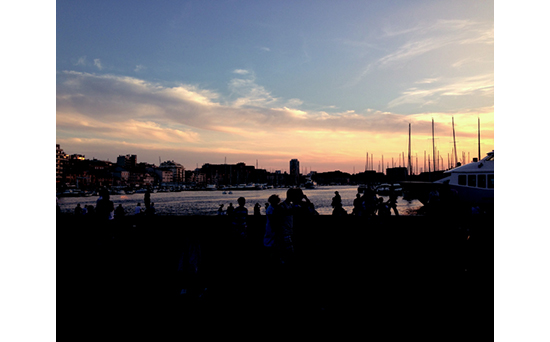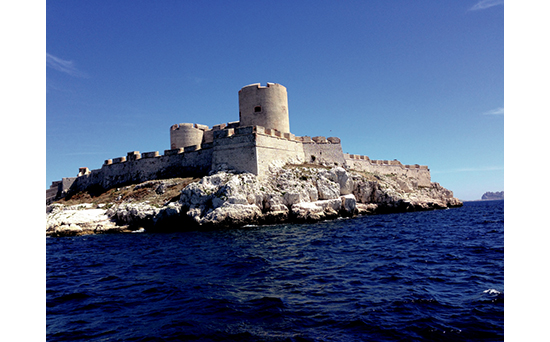
Some Scene in Marseille

Some Scene in Marseille

Some Scene in Marseille

Some Scene in Marseille
2000 years ago, the ancient Greek discovered and explored the Lacydon seaport along the Mediterranean, which was quite like a fairy tale. On the basis of this seaport, a city gradually grew up and finally became the second biggest city in France—Marseille.
When I came to Marseille, the Lacydon port, also known as Marseille port and the second biggest seaport in Europe, was no longer for ocean transportation and became an old port for yacht anchoring. Fascinated with old stories, I came to France only for Marseille. Walking randomly in various streets and lanes in this city, my resort was just this old port.
As my hotel was located in a secluded place with ancient simplicity, there were no crowds of tourists and thus I could enjoy the rare leisure in getting in and out casually. There was a routine bus heading for the old port. The vehicle looked quite like props running on track and it had two connections with a parallel pair of electric wires above. Obviously, it was a tram, an environment-friendly means of transportation. After living for a week in Marseille, I got totally familiar with this tram line. Sometimes, I would get on this tram alone, and after five stops, arrived at the old port.
I prefer to visit the old port at dusk when the sun, after a day’s labor, gets tired and then weakens its brilliance. Consequently, we could see that its radiance is no longer passionate and its luster becomes mild, which constitutes a pretty scene together with the nearby architecture, yachts and seagulls. On my way from the bus stop to the old port, four-storeyed old buildings stood on both sides, some musicians played their musical instruments in their favorite way and passengers hurried from and towards the old port. When I reached the end of this way, I found my vision much broader. It was indeed a reputable port as the spacious and straight stone path form a letter of “U” around the port. Standing at the bottom of this “U”, I could see the boundless ocean. I know that it was the exit of this old port, from where numerous vessels on countless far voyages set off here to head for varied places all over the world. It was all those vessels taking on countless far voyages that endowed Marseille with vitality and refreshed the whole France. On its left, I could find a hill, and on its top there stood a chapel whose acme high above cloud was the highest point of Marseille. There one could have an overview of the entire city. I once visited the chapel and standing by the chapel I observed every detail of the structure of Marseille port, including every sail on every yacht. As a matter of fact, the old port of Marseille is not old enough, in contrast with the new one that was lately completed. In the wake of the World War II, a reconstruction took place on the original site. Blessed with flourishing manufacture industry, prosperous trade and powerful economic development, Marseille demanded a port to connect the world. While transporting the merchandise from Provence to the world, it carried goods from all over the world back to Marseille. Such a commute finally becomes the motivation and vitality of a city and even a country.
The temperament in Marseille fascinated me completely. Without luxury and often in silence, it looks like a well-educated noble person who faces everything in cool and mild eyesight. However, a firm self-confidence is hidden behind such a cool and mild manner. As the port is always the economic center of a city, many key institutes are established in the neighborhood and thus much excellent architecture is erected as well. Opposite to the chapel on the mountain stands an oblong architecture in grey color. Rumor has it that it is a city hall with a history of more than two centuries. With a glimpse of it, I had a lot to say, but I preferred to keep silent. A higher building was behind it and at its gate there was a flat ground for orderly parking. Some people of fine costume and peaceful expressions entered and exited this building, some got into their cars, some walked around the port and some cruised to sea in yacht. My friend told me that it was the best hotel in Marseille with a fixed price of 200 euros per night for a standard room. I uttered “not expensive at all” and my friend replied immediately that the most expensive hotel was in China. It was quite true. I often had meals in many restaurants nearby the old port of Marseille where I could enjoy the exquisite wine from Bordeaux and seafood from the Mediterranean. A meal for four persons only cost 120 euros. The most expensive hotel is in China, and then the most expensive restaurant must be there as well. My friend and I laughed and we both had a tacit agreement as to why.
Within my half month in Marseille, I would visit the old port as soon as I had my spare time. I would gaze at every yacht heading for the ocean until it totally disappeared. Then I would ask myself whether it had gone to the ancient castle. Within an arrow’s distance, this ancient castle was built on an isolated island. It was said that it used to be a prison where Alexandre Dumas (Father) compiled the stories into his long novel The Count of Monte Cristo. So far, all the tourists to Marseille still take this legend for granted. Every day, many people would take a boat to get on the island to feel about the complicated plot and dramatic destiny in this novel. Of course I was no exception either, and on my fourth day in Marseille, I got on the isolated island to cater for this remote legend in the ancient castle. The castle resembled a labyrinth and through a narrow passage, I climbed onto the top and saw a hollow of 20 square meters below that was surrounded by small windows of iron bars. In the dim light from the windows, nobody could see what was inside. My friend, who had been there many times, told me that was prison, and many tourists tried to take a look through the small window. In my opinion, prison is a place to suffocate freedom and make life wither, so I held a fear rather than interest and preferred to get away from it. Then I advise to enjoy the sea.
The Mediter ranean really made me feel pleasant and comfortable, and it was at the old port of Marseille that I scooped up water of Mediterranean with my hands. Like emerald, the stream flowed from the slim crack between my fingers and my eyesight seemed to be green as well. The Mediterranean in the sunlight looked indeed azure, penetrating and clear. When taking a yacht to the ancient castle, I felt as if traveling on a blue carpet. With the undulating castle on the narrow isolated island ahead, the slow speed and long marching made me feel a genuine romance in Provence. My yacht stopped at simple anchor of the isolated island and I could see clearly those carefree in the front at the deep end of water from the port. What a clear and fascinating view! On this isolated island, I indulged myself in a dreamlike imagination.
Strolling nearby the old port of Marseille, I couldn’t help asking about my feelings, and two words occurred to my mind: natural and classical. The former was in vision and the latter was at heart. Marseille is a combination of natural beauty and classic beauty. With mountains behind and sea in the front, Marseille never finds turbulent waves or savage torrents. Therefore, the scenery here is of noble aesthetics and becomes a special part of the Mediterranean. From the source of Marseille port, we came to understand the historical deposit and as soon as the new port took up the economic burden of this city, the old port had its own memory to boast of. Like a retired soldier back home, it often recalls its glory in the past memory. The St. John Castle and the St. Nicolas Castle stand as the witnesses to the memory. Those ancient castles built in the reign of Louis XIV, like generals safeguarding the port, stand in a distance day by day, in order to tell the story of the old port from generation to generation.














